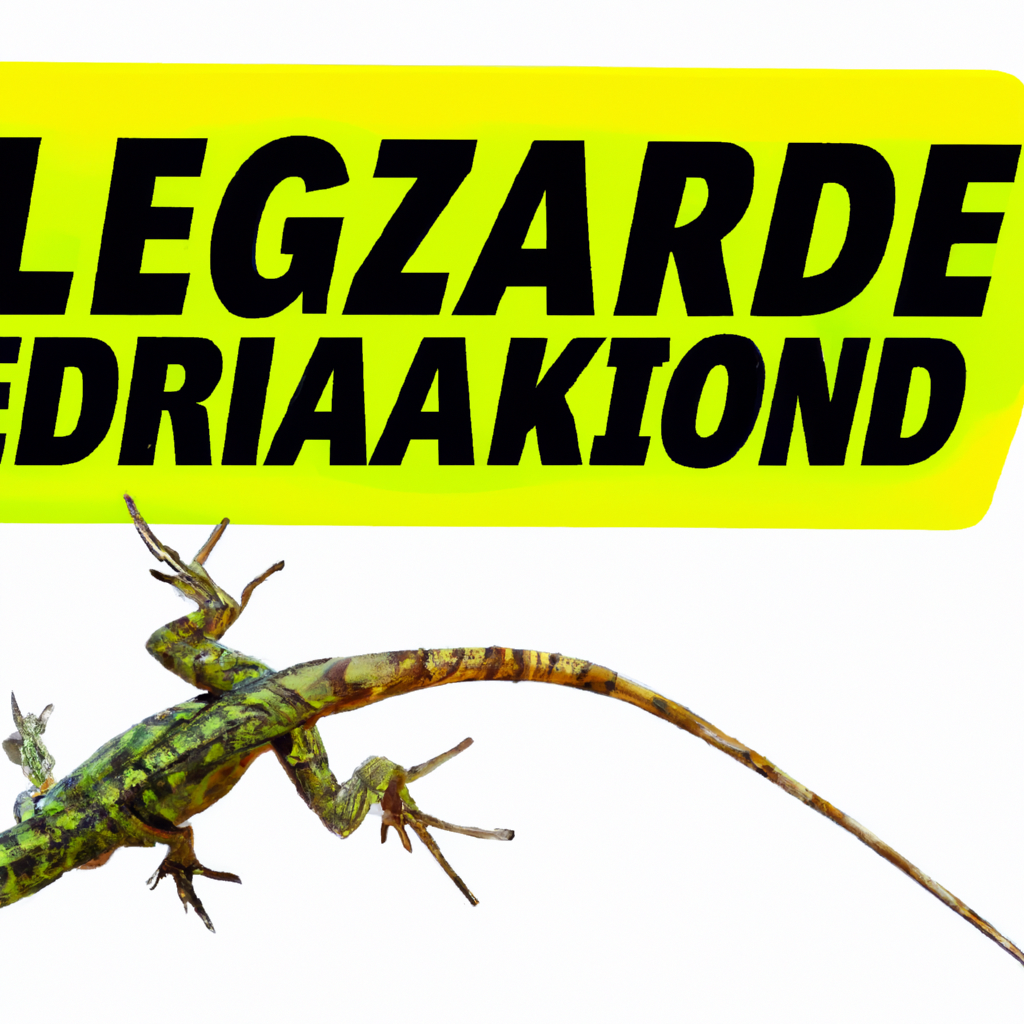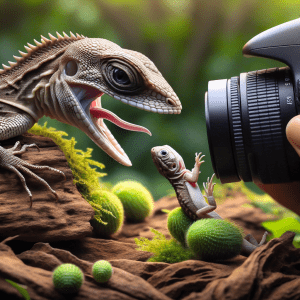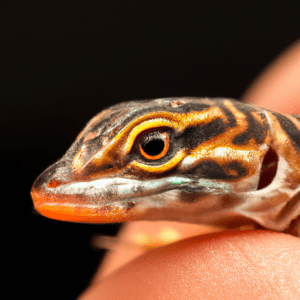Understanding the Importance of Lizard Emergency Preparedness
Hey, did you know that having a plan for lizard emergency preparedness is just as crucial as it is for humans? Yep, our scaly friends need our help too when it comes to facing unexpected situations. Imagine being a lizard owner and suddenly finding yourself in the midst of a natural disaster or emergency. Scary, right? That’s why it’s essential to be prepared in advance.
When it comes to understanding the importance of lizard emergency preparedness, it’s all about being proactive rather than reactive. I mean, have you ever thought about what you would do if a sudden emergency were to strike and you needed to ensure the safety and well-being of your pet lizard? It’s not something we like to dwell on, but being prepared can make all the difference in such situations.
Having a plan in place for your pet lizard’s safety during emergencies can give you peace of mind and ensure that you can act swiftly and effectively when needed. From knowing how to create a safe shelter for your lizard to having essential supplies on hand, being prepared can make a world of difference.
So, let’s delve into the world of lizard emergency preparedness together and explore all the ins and outs of keeping our scaly companions safe and secure in times of crisis. Trust me, by the end of this journey, you’ll feel more confident and prepared to handle any emergency situation that may come your way when it involves your beloved pet lizard. Let’s dive in and uncover the secrets to being a lizard emergency preparedness pro!
Common Emergency Scenarios for Pet Lizards
Let me tell you about some common emergency scenarios for pet lizards. It’s not something we often think about, but being prepared can make all the difference when it comes to our scaly friends.
Imagine this – you come home from work one day, excited to check on your lizard only to find that their terrarium has a crack in it! This could be a potential emergency situation, as the crack could lead to your lizard escaping or getting injured. It’s crucial to have a plan in place for such scenarios to ensure your pet’s safety.
Another scenario to consider is a power outage during extreme weather conditions. Without the proper heating and lighting, lizards can quickly become stressed and cold. Knowing how to keep your lizard warm and comfortable during such emergencies is essential to their well-being.
Now, here’s a practical tip for you – familiarize yourself with the signs of stress or illness in lizards. Sometimes, subtle changes in behavior or appearance can indicate that your lizard is not feeling well. By being attentive and proactive, you can address potential health issues before they escalate into emergencies.
It’s fascinating how these tiny creatures have their own set of needs and challenges, isn’t it? Understanding the common emergency scenarios for pet lizards can help us be better prepared caretakers and ensure that our scaly companions stay safe and healthy no matter what comes their way.
Creating a Lizard Emergency Kit: Essentials to Include
You know, when it comes to creating a lizard emergency kit, there are a few essentials you just can’t afford to miss. I remember when I first started putting mine together, I was a bit overwhelmed by all the options out there. But after some research and trial and error, I’ve got it down to a science.
One key tip I learned is to make sure you have a secure and portable carrier for your lizard in case you need to evacuate quickly. Something sturdy and well-ventilated is ideal. It’s also important to have a supply of your lizard’s favorite food and water in the kit, along with any necessary medications or supplements they may need.
Another practical advice is to include a small first aid kit specifically for your lizard. This should include items like sterile gauze pads, antiseptic wipes, tweezers, and a reptile-safe wound spray in case your lizard gets injured during an emergency.
Don’t forget to pack a heat source, such as a heat pack or hand warmers, especially if you live in a colder climate or in case of power outages. Lizards are cold-blooded creatures and need a warm environment to thrive.
Lastly, make sure to keep a copy of your lizard’s medical records, including any vet contact information, in your emergency kit. This can be crucial if you need to seek help for your lizard during a crisis.
By following these practical tips and putting together a well-thought-out lizard emergency kit, you’ll be better prepared to handle any unexpected situations that may arise and ensure the safety and well-being of your scaly friend.
Safe Shelter Options for Lizards During Emergencies
Let me tell you about creating safe shelter options for lizards during emergencies. It’s crucial to have a plan in place to ensure your scaly friend stays protected and comfortable when unexpected situations arise. Picture this – you come home to find a power outage or a storm brewing outside, and you need to act fast to safeguard your pet lizard.
Think of your lizard’s habitat as their safe haven. During emergencies, it’s essential to have alternative shelter options ready. This could include a portable carrier or a secure container that can be easily transported. Having a backup enclosure that is escape-proof and provides adequate ventilation is key to ensuring your lizard’s safety.
Now, here’s a practical tip: always have a designated emergency shelter area set up in advance. This area should be equipped with the necessary supplies, such as heat sources, water, and hiding spots, to keep your lizard comfortable during the crisis. Remember, a stressed lizard is more susceptible to health issues, so creating a stress-free environment is vital.
By planning ahead and familiarizing yourself with your lizard’s emergency shelter options, you can minimize the impact of unexpected events on your pet. It’s all about being prepared and proactive to ensure your scaly companion’s well-being. So, take some time to assess your lizard’s habitat and make the necessary arrangements to keep them safe during emergencies.
Remember, your lizard relies on you to provide a secure and nurturing environment, even in challenging situations. By having a well-thought-out emergency shelter plan in place, you can rest assured that you’re ready to face whatever comes your way while keeping your lizard protected and cared for.
First Aid Tips for Injured or Stressed Lizards
Let me tell you about some first aid tips for injured or stressed lizards. It’s crucial to be prepared for these situations because you never know when your scaly friend might need your help. One time, my bearded dragon got a little too adventurous and ended up with a small cut on his tail. I freaked out at first, but knowing what to do in that emergency situation really helped calm my nerves.
When it comes to treating injured or stressed lizards, it’s important to stay calm and act quickly. One practical tip is to have a lizard first aid kit on hand. This kit should include items like sterile gauze, antiseptic wipes, and styptic powder to stop bleeding from minor cuts or injuries. Remember, lizards can be delicate creatures, so it’s essential to handle them gently and with care when providing first aid.
Another useful tip is to create a quiet and warm environment for your lizard to help reduce stress. Keep them in a quiet area away from loud noises and sudden movements. Providing a warm and comfortable hiding spot can also help your lizard feel safe and secure during the recovery process.
Have you ever had to provide first aid to your lizard? What was your experience like? It’s interesting how these small reptiles can sometimes surprise us with their resilience. By being prepared and knowing how to handle emergency situations, you can ensure that your lizard receives the care and attention they need to recover quickly and stay healthy.
Evacuation Strategies for Lizard Owners
You know, when it comes to emergency situations, having a solid evacuation strategy in place is key. So, I wanted to share some practical tips with you on how to prepare for evacuating your pet lizard in case of an emergency. First off, it’s important to have a designated evacuation carrier or container for your lizard. This should be secure, well-ventilated, and large enough for your lizard to move around comfortably.
Another essential tip is to keep a supply of your lizard’s food and water in the evacuation kit. This will help ensure that your pet has access to essential nourishment during the evacuation process. Additionally, having a heat source such as a heat pad or warming pack can be crucial, especially if you live in a colder climate or are evacuating to a temporary location without proper heating.
It’s also wise to familiarize yourself with potential evacuation routes and safe locations in advance. Knowing where you can go in case of an emergency will save you time and stress when the situation arises. Practice evacuating your lizard from its enclosure regularly so that both you and your pet are accustomed to the process.
Lastly, make sure to have a list of emergency contacts, including veterinarians or reptile experts, saved in your phone or written down in your evacuation kit. In times of crisis, having access to trusted professionals can make a world of difference for your lizard’s well-being.
By following these practical tips and staying prepared, you’ll be better equipped to handle emergency evacuations with your pet lizard. Remember, being proactive and having a plan in place can go a long way in ensuring your pet’s safety and security during challenging times.
Communication and Coordination in Lizard Emergency Situations
Picture this: you’re in the midst of a lizard emergency situation – chaos, uncertainty, and your beloved reptilian friend in need of help. Coordination and communication become your best friends in times like these. It’s like you’re the leader of a lizard rescue mission, ensuring that everyone is on the same page and working towards the common goal of keeping your scaly buddy safe.
Imagine yourself as the captain of a tiny, reptilian spaceship, navigating through the challenges of an emergency scenario with precision and clarity. Your crew, consisting of fellow lizard lovers and emergency responders, looks to you for guidance and direction. Communication is key as you relay important information, assign tasks, and ensure that everyone is informed and ready to act swiftly.
In this lizard emergency universe, the coordination between you and your team is crucial. Just like a well-oiled machine, each part needs to work seamlessly with the others to ensure a successful rescue mission. It’s about being proactive, staying organized, and having a clear plan in place for any unforeseen circumstances that may arise.
By embracing this unique perspective and viewing lizard emergency preparedness through the lens of a space adventure, you can approach the topic with creativity and imagination. Remember, being prepared for emergencies doesn’t have to be daunting – it can be an opportunity to showcase your leadership skills and ability to navigate challenging situations with grace and determination.
So, gear up, captain! Your lizard crew is counting on you to steer them through the storm and emerge victorious on the other side. With effective communication and coordination, you can ensure that your scaly companions are safe, sound, and ready to embark on many more adventures in the future.
Training and Preparedness Drills for Lizard Owners
Let’s dive into the topic of training and preparedness drills for lizard owners. It may sound a bit unusual at first, but trust me, it’s crucial for ensuring the safety of your scaly companion in emergency situations. Picture this: you’re faced with a sudden power outage or a natural disaster, and you need to act fast to protect your lizard friend. That’s where having practiced drills and being prepared can make all the difference.
Imagine setting aside some time each month to run through different emergency scenarios with your lizard. It’s not as daunting as it seems; in fact, it can be a fun and educational experience for both you and your pet. By practicing how to safely transport your lizard, administering first aid, or evacuating to a safe location, you’ll be better equipped to handle real-life emergencies with confidence.
Now, here’s a practical tip to make these drills more effective: consistency is key. Make it a routine to review your emergency plan and conduct drills regularly. This way, you’ll build muscle memory and ensure that you can act swiftly and decisively when the need arises. Plus, it’s a great bonding experience with your lizard, strengthening your relationship and trust.
By incorporating training and preparedness drills into your routine, you’re not just preparing for the worst-case scenarios; you’re also fostering a sense of responsibility and care for your pet. It’s about being a proactive and attentive lizard owner, ready to face any challenges that may come your way.
So, why not take a proactive approach to lizard emergency preparedness and start practicing those drills today? Your lizard will thank you for it, and you’ll have peace of mind knowing that you’re prepared for whatever may come your way.
Resources and Organizations for Lizard Emergency Preparedness
Imagine if every lizard owner took proactive steps to prepare for emergencies involving their pets. The impact would be significant, not only for the individual lizards but also for the broader community of reptile enthusiasts. By being well-prepared, you’re not only safeguarding the well-being of your beloved lizard but also setting a positive example for others to follow.
When we think about the resources and organizations available for lizard emergency preparedness, it becomes clear that there is a growing recognition of the importance of caring for these unique pets in all circumstances. The existence of such resources indicates a shift towards a more responsible and compassionate approach to pet ownership, extending beyond just the basic necessities.
By tapping into these resources and connecting with like-minded individuals who prioritize lizard emergency preparedness, you’re contributing to a collective effort to elevate the standards of care for pet lizards. This community support can be invaluable during challenging times, providing guidance, support, and a sense of solidarity when facing emergencies together.
Moreover, the significance of being prepared for lizard emergencies goes beyond just the immediate safety of your pet. It reflects a deeper sense of responsibility and commitment to the well-being of all creatures, no matter how small or scaly. As you delve into the world of lizard emergency preparedness, you’re embracing a mindset of proactive care and resilience that can have ripple effects in the larger pet care community.
So, let’s continue to explore, learn, and share knowledge about lizard emergency preparedness, not just for our own pets but for the greater good of all lizard companions out there. Together, we can make a difference and create a safer, more caring environment for these fascinating creatures.
Taking Action to Protect Your Lizard in Emergencies
Imagine this – you’re peacefully chilling with your pet lizard, when suddenly a power outage hits your area. What do you do? That’s where the importance of lizard emergency preparedness comes in. You need to be ready for any unexpected situation that could potentially jeopardize your lizard’s well-being.
Now, let me share a personal anecdote related to lizard emergency preparedness. My friend once had a close call when a wildfire broke out near their home. They had to quickly evacuate, but were unprepared for how to safely transport their pet lizard. Luckily, they had a basic emergency kit on hand, which made all the difference in ensuring their lizard’s safety during the evacuation.
II. Common Emergency Scenarios for Pet Lizards
Have you ever wondered about the common emergency scenarios that pet lizards might face? From power outages to extreme weather events, lizards can be vulnerable in various situations. It’s crucial to be aware of these scenarios so that you can proactively prepare for them and protect your scaly friend.
Let’s delve into an interesting fact about lizards – did you know that some lizard species have the ability to detach their tails as a defense mechanism? While this is a fascinating adaptation in the wild, it’s essential to understand that such stress responses can also occur in emergency situations. Being prepared can help minimize stress and ensure your lizard’s safety.
III. Creating a Lizard Emergency Kit: Essentials to Include
When it comes to creating a lizard emergency kit, there are certain essentials you should always have on hand. From extra heat sources to first aid supplies, a well-stocked emergency kit can make all the difference in a crisis. Stay tuned as we explore the must-have items for your lizard’s emergency preparedness kit.



